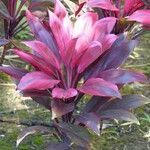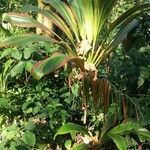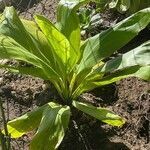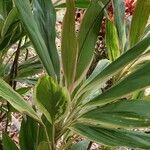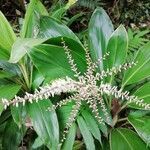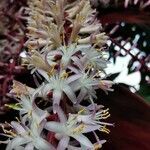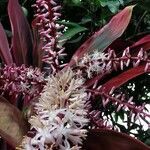An erect, suckering, clump forming, bush. It grows 2-5 m high. It reaches 1-2.5 m across. Normally the stems don't branch. Older trees form branches higher up. The stems are woody and covered with leaf scars. Often the leaves taper at the base, and have a bluntly pointed tip. The leaf petiole is broad and clasps the stem. It is short and has a channel along it. The leaves are strap shaped, and occur in a crown at the top and clustered in spirals near the end of the stem. The leaves are 75 cm long by 15 cm wide. The leaves are green. Some kinds have leaves with yellow or red stripes. They are 30-60 cm long. The flowers are 0.8 cm long and purple. It produces white to purple flowers in loose panicles, which are 30-60 cm long. The fruit are bright red berries. They are 8-12 mm across.
Shrub, often single-stemmed, usually 2–3 m high, rarely to 5 m; stems and leaves sometimes reddish. Leaves 25–80 cm long, 5–12 cm wide; lamina abruptly contracted to petiole 8–20 cm long and concave above. Panicles 20–30 cm long; scape 15–20 cm long; flowers sessile or on pedicels to 2 mm long. Sepals and petals equal, 9-12 mm long, glabrous. Fruit c. 1 cm diam., reddish.
